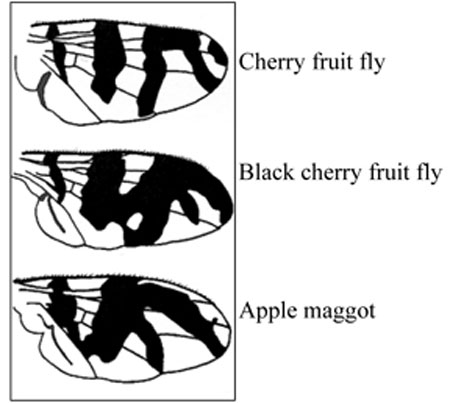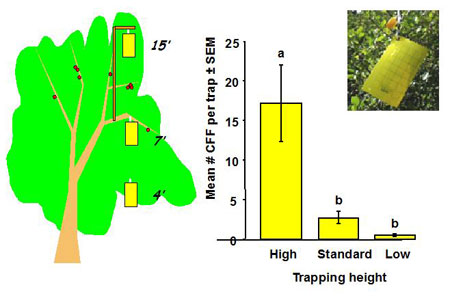Cherry fruit fly monitoring and management
It’s time to monitor for cherry fruit flies in Northwest Michigan cherry orchards.

Cherry fruit fly traps were deployed at the Northwest Michigan Horticultural Research Station last Friday, June 9. 2014. Here at the station we have accumulated 393 growing degree days (GDD) and should begin seeing cherry fruit fly emergence within the next one to two weeks.
There are two species of true fruit flies in the Tephritidae family that attack sweet and tart cherries: the cherry fruit fly (Rhagoletis cingulata) and the black cherry fruit fly (Rhagoletis fausta). The former species, R. cingulate, is typically more common or abundant. Adult flies of both species are approximately 4.5 millimeters with black bodies, yellow to brown heads and legs, and a light dot on the flies’ back. Possibly the most prominent characteristic of these flies are the black markings on the flies’ wings which can be used to differentiate fruit flies in the Tephritidae family. Wing patterns on cherry fruit flies and black cherry fruit flies are distinct and can be used to separate these species. The cherry fruit fly wing pattern has a black shape that looks like the pi symbol with a black partial circle marking on the tip of the wing, whereas the black cherry fruit fly has thicker black bands that extend to the wing margin.

In early summer, adult cherry fruit flies emerge from their puparium where the maturing fruit fly overwintered since the previous fall. After emergence, adults spend approximately 10 days in a pre-egglaying feeding period. After mating, female cherry fruit flies puncture the skin of fruit and lay an egg inside of the fruit. Maggots, or larvae, hatch from eggs and feed inside the ripening fruit. This is a serious concern in cherries due to the industry standard of zero tolerance for larvae in fruit.
When considering management of these flies, cherry fruit flies and black cherry fruit flies are treated as one species because the flies’ life cycles are nearly identical and control measures that are effective for one of the species are effective for both species. Cherry fruit fly control is targeted at the adult flies during the pre-egglaying feeding stage. Therefore, monitoring for the first emergence of cherry fruit flies is critical for determining when to take management action.
Growers, consultants, educators and researchers use yellow sticky traps baited with ammonia acetate that are attached to a tree branch with a twist-tie to monitor for cherry fruit flies. At the research station, we place 1 teaspoon of ammonium acetate powder into small containers that have a hole on one side. These containers are attached to the yellow sticky trap with a twist-tie.
Previous research conducted by Michigan State University Extension demonstrated that the number of cherry fruit flies caught in traps increases as the height of trap placement in the tree canopy increases. Here at the station, we attach cherry fruit fly traps to bamboo poles, like the poles used to hang codling moth delta traps, to hang traps high in the tree canopy. The poles have a flexible plastic cage in which we place the baited yellow sticky trap; the cage prevents leaves and branches from getting stuck to the trap. Adding a flexible hooked end to the pole can help to secure the trap high in the tree canopy. Finally, remove all sticky traps from trees prior to shaking at harvest time to avoid getting sticky material on cherries.

Figure courtesy of Larry Gut et al.
Dr. Rothwell's work is funded in part by MSU's AgBioResearch.



 Print
Print Email
Email



